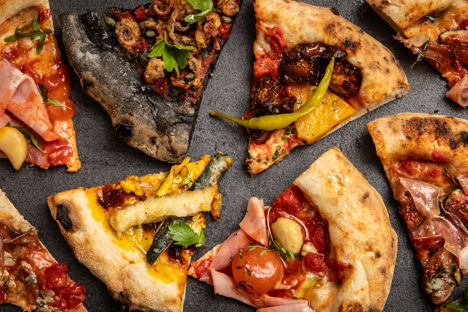To Italians, pizza holds a special place in their culinary and cultural heritage, absorbing qualities of the country's regional diversity and rich history. The art of pizza-making is recognised by UNESCO as an intangible cultural heritage, showcasing Italy’s dedication to preserving their cultural culinary traditions. To many, pizza is more than just a food, it is a symbol of national pride and a testament to the ability to create something universally loved from the simplest of ingredients.
Making pizza at home is a surprisingly straightforward process. To make the dough, you need a few basic ingredients: flour, water, yeast, salt, and a dash of olive oil. You can also use a sourdough starter instead of yeast, but if you don’t have a starter at home instant yeast works just as well. Begin by dissolving the yeast in warm water with a pinch of sugar, then mix this with the flour and salt, gradually adding water until the dough comes together. Knead the dough on a floured surface until it becomes smooth and elastic, then place the dough into a lightly oiled bowl, cover it with a tea towel and leave to rise for 1-2 hours, or until doubled in size. After rising, punch down the dough and divide into portions, roll or stretch each of them out to your desired thickness before shaping and adding toppings.
To shape the dough, place your portion of dough onto a lightly floured surface and gently press it down with your fingers to flatten it into a disc. Avoid pressing down the outer ring so that you create a thicker edge. Using your fingertips, push from the centre outward to shape the crust further. Lift the dough onto the back of your hands and let gravity help to stretch it, rotating it to balance out the stretching. Be cautious not to tear the dough. You should aim for an even thickness around the centre with a slightly thicker border for the crust. If the dough keeps springing back or seems to resist stretching, let it rest for a few minutes before continuing with the shaping process.
A classic pizza sauce is typically made by blending canned tomatoes (preferably San Marzano for their sweetness and low acidity) with garlic, olive oil and a mix of Italian herbs such as oregano, basil and thyme. Add a pinch of salt and sugar to balance the acidity, then simmer for 30 minutes until thickened. White pizza sauces are usually a béchamel base, with added garlic and parmesan cheese.
Metric
Imperial
- 325ml of warm water
- 1 pinch of caster sugar
- 7g of active dry yeast
- 500g of strong bread flour
- 10g of salt
- 3 tbsp of tomato sauce
- 150g of mozzarella cheese, grated or sliced
- 1 handful of fresh basil
- 1 tbsp of extra virgin olive oil, for drizzling
Begin by preparing the dough
Dissolve the yeast in the warm water along with a pinch of sugar. Let it sit at room temperature for 10 minutes until frothy
- 7g of active dry yeast
- 325ml of warm water
- 1 pinch of caster sugar
In a large bowl, combine the flour and salt then make a well in the centre before adding the yeast mixture and olive oil
- 500g of strong bread flour
- 10g of salt
Mix until a dough forms, then turn it out onto a floured surface and knead for about 10 minutes until smooth and elastic
Place the dough in a lightly oiled bowl, cover with a damp cloth, and let it rise in a warm place for about 1-2 hours, or until it has doubled in size
Preheat your oven to its highest setting (250-260°C) and place a pizza stone or baking tray inside to heat
Punch down the risen dough and divide it into two equal portions. Roll out each portion on a floured surface to your desired thickness
Use your fingertips to lightly press down the dough from the centre, avoiding the edge creating a rim for the crust
Lift the dough onto the back of your hands and let gravity help to stretch it, rotating it as you go around to balance out the stretching
Transfer the rolled-out dough onto a piece of parchment paper
Spread a thin layer of tomato sauce over the dough, leaving a small border for the crust
- 3 tbsp of tomato sauce
Arrange the mozzarella evenly over the sauce
- 150g of mozzarella cheese, grated or sliced
Carefully transfer the pizza on the parchment paper to the preheated pizza stone or baking sheet
Bake for 10-12 minutes, or until the crust is golden and the cheese is bubbly and slightly browned
Remove from the oven and immediately scatter fresh basil leaves over the hot pizza. Drizzle with a little olive oil before serving
- 1 handful of fresh basil
- 1 tbsp of extra virgin olive oil, for drizzling
The best way to store pizza to maintain its flavour and texture is to first let it cool to room temperature. Once cooled, place the slices into an airtight container, separating each slice with some parchment paper to prevent sticking. For short term storage, keep them in the fridge where they will stay fresh for up to a week. If you need to store them for a longer time period, you can even freeze the slices making them last for up to 2 months. The best way to freeze them is to individually wrap the sliced in cling film or tin foil, then place them in a resealable freezer bag. When ready to reheat them, you can reheat them directly from the freezer by placing them in the oven at 190°C until fully heated through.
The best way to reheat single slices of pizza is in a frying pan. Preheat the frying pan, then, once hot, add the pizza. After a minute or two, add a small splash of water and cover with a lid. This method ensures the base of the pizza stays crisp while the top steams.
At Great British Chefs, we have a variety of in-house and chef developed pizza recipes to choose from. Whether you are looking for a classic Sicilian-style pizza like Helen Graves’s, a simple Pizza Caprino like Paul Ainsworth’s, or something with vibrant flavours like Thuy Diem Pham’s Vietnamese pizza, have a look through our collection of tried and tested pizza recipes.
Get in touch
Please sign in or register to send a comment to Great British Chefs.


